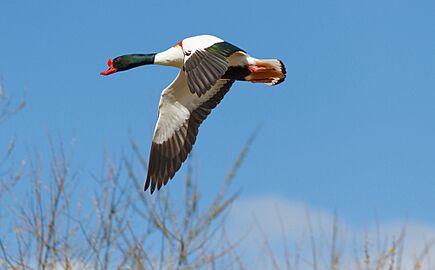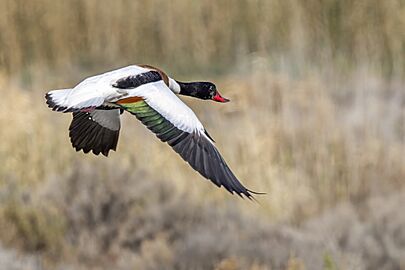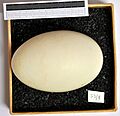Common shelduck facts for kids
Quick facts for kids Common shelduck |
|
|---|---|
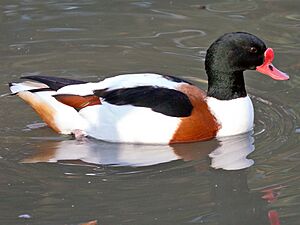 |
|
| Breeding male | |
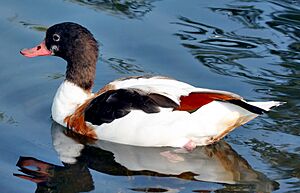 |
|
| Adult female | |
| Conservation status | |
| Scientific classification | |
| Genus: |
Tadorna
|
| Species: |
tadorna
|
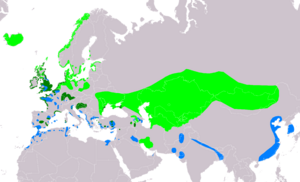 |
|
| Range of T. tadorna (Compiled by BirdLife International and Handbook of the Birds of the World (2019) 2019.) Breeding Resident Non-breeding | |
| Synonyms | |
|
Anas tadorna Linnaeus, 1758 |
|
The common shelduck (Tadorna tadorna) is a type of large waterfowl bird. It belongs to a group of birds called shelducks. These birds are found across a wide area of Europe and Asia. They usually breed in places with mild weather. In winter, they fly to warmer, subtropical areas. You can also find them in North Africa during the colder months.
Contents
Naming the Common Shelduck
How the Bird Got Its Name
The common shelduck was officially named by a Swedish scientist named Carl Linnaeus. He gave it the name Anas tadorna in 1758. This was in the tenth edition of his famous book, Systema Naturae.
Linnaeus learned about this bird from an English scientist, Eleazar Albin. Albin had described and drawn "The Sheldrake or Burrough-Duck" in 1731.
Meaning of the Name
The word Tadorna comes from a French word for this bird. A French scientist named Pierre Belon used this name in 1555. It might come from old Celtic words. These words mean "pied waterfowl," which means a water bird with two or more colors. This is similar to the English word "shelduck."
Today, the common shelduck is part of the Tadorna group of birds. This group was named in 1822 by a German scientist, Friedrich Boie. This bird is a "monotypic" species. This means there are no different types or subspecies of the common shelduck.
What Does a Common Shelduck Look Like?
Size and Colors
The common shelduck looks a bit like a small goose. It has a short neck and is about the same size as a goose. It's a very eye-catching bird with bright colors.
It has a reddish-pink beak and pink feet. Its body is white with patches of chestnut brown. It also has a black belly. Its head and neck are a dark green color.
Wing and Feather Details
The feathers on its wings are white. The main flight feathers are black. The feathers on the back part of its wings are green and chestnut. You can only see these colors when the bird is flying. The feathers under its wings are almost completely white.
Males, Females, and Young Birds
Male and female shelducks look similar. However, the female is a bit smaller. She might also have some white markings on her face. During the breeding season, the male looks especially bright. His beak turns a very bright red, and he has a noticeable knob on his forehead.
Baby shelducks, called ducklings, are white. They have a black cap on their head, a black back of the neck, and black patches on their wings and back. Young shelducks look similar. They are grayish on top and mostly white underneath. But they already have the same wing pattern as the adult birds.
Shelduck Sounds
The common shelduck makes a loud honking sound.
Where Do Common Shelducks Live?
Breeding and Wintering Areas
These birds breed in areas with mild weather across Europe and Asia. Most common shelducks fly to warmer, subtropical places for the winter. However, some stay all year in western Europe. These birds might move to special places to moult, which is when they shed their old feathers. A popular moulting spot is the Wadden Sea off the coast of northern Germany.
Favorite Habitats
The common shelduck is very common along the coasts of Great Britain and Ireland. In these places, it is often just called the "shelduck." They like to live in salt marshes and estuaries, which are places where rivers meet the sea.
They often make their nests in rabbit burrows. Sometimes, they nest in tree holes, haystacks, or similar spots. In winter, they are often found on suitable estuaries and muddy areas exposed at low tide.
Rare Sightings
It is rare to see common shelducks in North America. They are only reported as occasional visitors to the United States and Canada.
Common Shelduck Behavior
Moulting and Crèches
When common shelducks moult, they gather in very large groups. Sometimes, there can be as many as 100,000 birds in one place, like the Wadden Sea. This happens because most parent birds leave their young in a "crèche." A crèche is like a nursery where many young birds are looked after by just one or two adult birds.
Protecting Young Birds
Young shelducks are very clever. If a predator tries to catch them, they will dive underwater to hide. The adult shelducks will fly away from the young ones. They do this to trick the predator and draw its attention away from the ducklings.
Conservation Efforts
The common shelduck is one of the birds protected by the Agreement on the Conservation of African-Eurasian Migratory Waterbirds (AEWA). This agreement helps protect birds that migrate across Africa and Eurasia.
-
Adults mating in Lancashire (UK). Notice the size difference between the male (right) and female.
-
Ducklings on Borkum, Germany.



